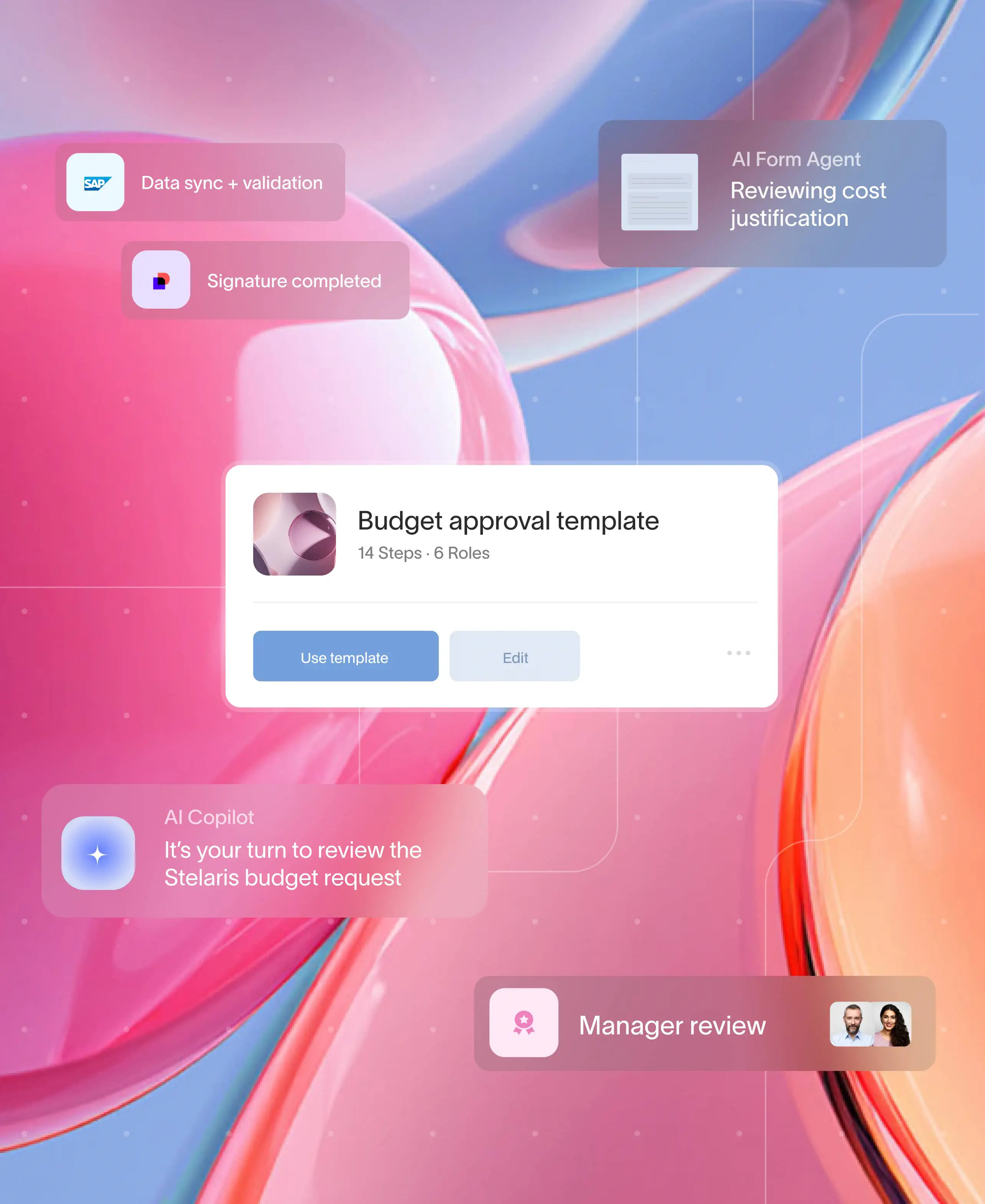
At a glance
- A well-structured client reporting portal eliminates fragmented updates and accelerates communication clarity.
- Centralizing campaign data, approvals, and feedback fosters faster decision-making and a more professional client experience.
- Moxo customer 1852 Media increased client capacity by 30% per manager after automating campaign workflows.
- Real-time visibility into campaign progress turns reporting into a service differentiator, not a post-mortem.
The hidden cost of fragmented reporting
Marketing campaigns rely on clean reporting. But getting clean reporting to clients? That’s a mess. Stakeholders chase updates across email threads. Designers upload the wrong file version. Account managers wait days for simple approvals.
That lag time shows up in retention rates.
Clients don’t churn because your work is bad- they churn because communication is. And if your reporting and communication happen across five tools and three workflows, your agency looks disorganized, even if the execution is solid.
It’s time to reframe the client reporting process as a product experience. That’s where a client reporting portal delivers real value.
Why reporting delays erode trust
Client communication should move as fast as your campaigns. But too often, reporting becomes a series of follow-up emails, manual updates, and missed context. What should be a moment to reinforce value instead turns into a frustrating back-and-forth that costs time and confidence.
Clients aren’t just looking for metrics; they want a sense of momentum. When updates arrive late or approvals stall, it casts doubt on performance, even if results are strong. And when reporting workflows span across multiple tools and formats, it creates gaps that invite confusion.
A client reporting portal eliminates this noise. It creates a single destination where data, assets, feedback, and context come together. Not just for easier reporting, but for stronger relationships built on transparency and consistency.
What a client reporting portal actually solves
A client reporting portal isn't just a dashboard. It’s a structured environment where updates, context, and collaboration are delivered as part of the service. For marketing agencies, that means fewer manual updates, faster approvals, and more time focused on strategic work.
Here’s what it replaces:
- Scattered communication becomes a single, persistent thread. No one has to search for who said what or which version of a report was approved.
- Manual report compilation is replaced by live progress visibility. Stakeholders see timelines, milestones, and performance data without waiting for a deck.
- Feedback loops are integrated, not improvised. Annotations, approvals, and comments happen in context, inside the portal—not across random emails.
This structure isn’t just cleaner. It builds trust. When clients know where to go for updates and see consistent delivery, reporting becomes a proof point for operational excellence, not a recurring fire drill.
Moxo’s client portal framework is built around this principle. Agencies like 1852 Media used it to increase client capacity by 30% per manager, all while reducing internal coordination time.
Unifying campaign execution and reporting in one workflow
Campaign delivery and client reporting are often treated as separate workflows. One lives inside internal project trackers. The other is cobbled together for client updates. That separation creates duplication, delays, and disconnects.
A client reporting portal brings those two streams together.
Instead of wrapping up a campaign sprint and then translating the results into a client-friendly format, teams report directly from the source of truth. Task completion, creative approvals, performance data, and feedback live in one space—already organized for both internal execution and external visibility.
This structure helps in three critical ways:
- Real-time visibility builds confidence
Clients can log in and see progress without waiting for updates. That sense of transparency reduces the need for check-ins and builds trust in the agency’s process.
- Approvals happen in context
Designs, copy, and budgets don’t float in emails. They’re reviewed, annotated, and signed off where the rest of the campaign lives. No version control issues. No lost threads.
- Reporting becomes continuous, not reactive
Instead of scrambling to assemble a report before a client meeting, status is always up to date. This makes reporting an embedded value- something clients experience every day, not just once a month.
Agencies using Moxo’s workflows report significant gains. Webware, a digital marketing firm, reduced feedback loop delays by half after centralizing campaign versioning and approvals in their Moxo-powered portal.
The ROI of a client reporting portal
The value of a client reporting portal shows up in three measurable ways: time saved, client retention improved, and internal capacity expanded. Agencies that unify their communication and reporting don’t just streamline work; they change how clients perceive their service.
1. Time savings from reduced manual updates
Account managers spend hours each week pulling data, formatting slides, and chasing internal updates. A portal automates this. Reports are built from live activity, approvals are tracked automatically, and clients can self-serve updates. That translates to fewer meetings, fewer follow-ups, and faster execution.
2. Increased client retention through transparency
Clients want to feel progress. When they can log in, view results, and offer input without needing a status call, it signals professionalism and control. Agencies that offer this kind of visibility see stronger relationships and longer engagements.
Moxo customer 1852 Media didn’t just save time—they were able to increase client load by 30 percent per manager. That growth came from eliminating friction in approvals and giving clients structured visibility into campaign workflows.
3. Higher operational capacity
When your team isn’t duplicating effort between internal and external systems, they get more done. Fewer miscommunications. Fewer manual tasks. More time on strategy, creative, and growth. A client reporting portal enables each team member to manage more without burnout.
How Moxo supports structured client reporting
Moxo is built to simplify service delivery, especially when client communication, data, and approvals need to move in lockstep. For marketing agencies, that means turning reporting into a seamless, ongoing experience rather than a reactive chore.
Here’s how agencies use Moxo as a client reporting portal:
- Dedicated client portal
Each client gets their own white-labeled portal with role-based access. Campaign timelines, deliverables, and approvals are all centralized in one secure environment.
Task handoffs, approval checkpoints, and deadline nudges run automatically. When a creative round is ready, the client sees it, reviews it, and signs off.
- Integrated feedback and version control
Assets are annotated directly inside the portal. Everyone sees the most recent version, and prior feedback stays attached to the asset for full context.
- Live visibility without follow-ups
Clients don’t need to ask for updates. They can check their portal and see what’s completed, what’s in review, and what’s next. That sense of transparency builds trust and reduces unnecessary communication.
Agencies like Trigger Digital use Moxo to centralize campaign asset approvals. With dedicated tools for annotation and structured feedback, they’ve streamlined their review cycles and improved overall campaign delivery speed.
Moxo doesn’t replace the creative work, it removes the friction around it. By unifying reporting, communication, and approvals, it lets teams focus on the work that drives outcomes.
Ready to simplify how you deliver results?
Client reporting doesn’t have to be another project. With the right structure, it becomes an always-on part of your service- a signal to clients that they’re in good hands.
A client reporting portal gives you that structure. It eliminates update delays, streamlines approvals, and brings everything into one place where clients feel informed, engaged, and confident.
If you’re ready to turn reporting into a competitive advantage, it starts here.
Book a demo with Moxo and see how leading agencies are scaling smarter.
FAQs
What is a client reporting portal?
A client reporting portal is a secure, centralized workspace where agencies share updates, deliverables, and campaign metrics with clients in real time. It replaces ad hoc emails and fragmented communication with a single structured experience.
Can Moxo integrate with my reporting tools?
Yes. Moxo integrates with CRMs, cloud storage, and data platforms through APIs and embeddable workflows. You can connect data from your existing systems into the portal experience.
Is this different from a project management tool?
Yes. Project management tools are often internal-facing. A client reporting portal is built specifically for the client experience. It simplifies how you present progress, collect feedback, and deliver work externally.
What kind of agencies use Moxo?
Creative, digital, content, and performance marketing agencies use Moxo to streamline everything from onboarding to campaign execution. Whether you’re running large accounts or scaling fast, Moxo’s structure helps reduce overhead and improve delivery.
How long does it take to set up a reporting portal in Moxo?
Most agencies can launch their first client portal within days. Moxo provides guided setup, reusable templates, and customization options for branding and workflows.





